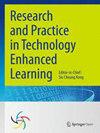Interaction support systems between teachers and visual content for effortless creation of program visualization
IF 3
Q1 EDUCATION & EDUCATIONAL RESEARCH
Research and Practice in Technology Enhanced Learning
Pub Date : 2023-01-02
DOI:10.58459/rptel.2023.18033
引用次数: 0
Abstract
Several program visualization (PV) systems have been developed to support novice learners in understanding program behavior since last couple of decades. However, only a few have been introduced or continuously used in actual classes. One of the main obstacles to using PV systems in actual classrooms is the significant amount of time needed to integrate them into actual educational settings. We developed a PV system called Teacher’s Explaining Design Visualization Tool (TEDViT) and introduced it into several practical applications. Although programming learning with TEDViT had a noticeable effect, the time required for PV customization (i.e., the time consumed for interactions between teachers and PV content) was a non-trivial problem. In this study, we describe three approaches to reduce the time cost of customizing by teachers; that is, we supported PV creation by (1) semi-automatically arranging drawing objects oriented toward novice learners, (2) allowing menu operations with a dialog interface, and (3) providing visual information and visual operations using a WYSIWYG PV editor. We developed three individual systems based on each approach and evaluated their effortlessness by measuring the time required for actual PV creation. The evaluation results suggest that each of the three approaches has a certain effect on improving the effortlessness of PV creation. This study describes our three approaches and the system developed based on them and discusses the possibility of integrating them.教师和可视化内容之间的交互支持系统,轻松创建程序可视化
在过去的几十年里,一些程序可视化(PV)系统已经被开发出来,以帮助初学者理解程序行为。然而,只有少数被引入或在实际课堂中持续使用。在实际教室中使用光伏系统的主要障碍之一是需要大量的时间将其整合到实际的教育环境中。我们开发了一个名为“教师讲解设计可视化工具”(TEDViT)的PV系统,并将其引入到几个实际应用中。尽管使用TEDViT进行编程学习具有明显的效果,但PV定制所需的时间(即教师与PV内容之间的交互所消耗的时间)是一个不容小觑的问题。在本研究中,我们描述了三种降低教师定制时间成本的方法;也就是说,我们通过以下方式支持PV创建:(1)面向新手学习者的半自动排列绘图对象,(2)通过对话界面允许菜单操作,(3)使用WYSIWYG PV编辑器提供可视化信息和可视化操作。我们基于每种方法开发了三个单独的系统,并通过测量实际PV创建所需的时间来评估它们的轻松性。评价结果表明,三种方法对提高光伏发电的无效性都有一定的效果。本研究描述了我们的三种方法和基于它们开发的系统,并讨论了整合它们的可能性。
本文章由计算机程序翻译,如有差异,请以英文原文为准。
求助全文
约1分钟内获得全文
求助全文
来源期刊

Research and Practice in Technology Enhanced Learning
Social Sciences-Education
CiteScore
7.10
自引率
3.10%
发文量
28
审稿时长
13 weeks
 求助内容:
求助内容: 应助结果提醒方式:
应助结果提醒方式:


